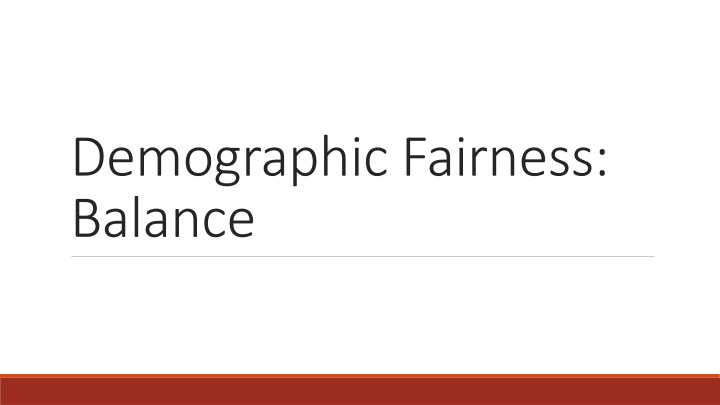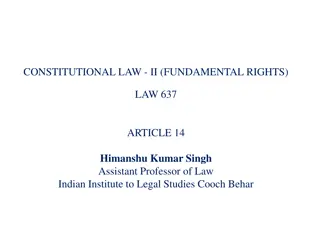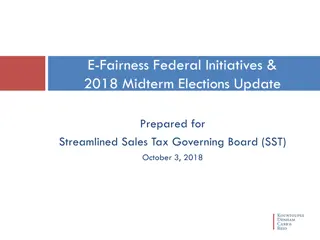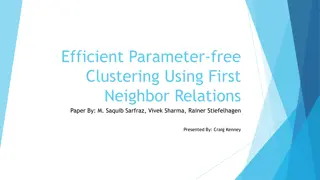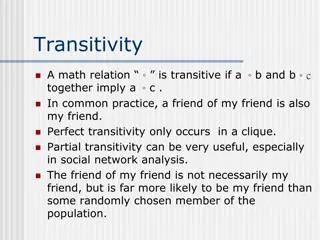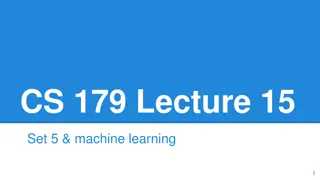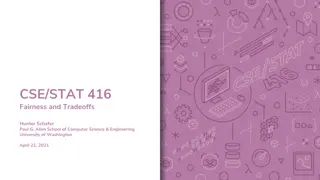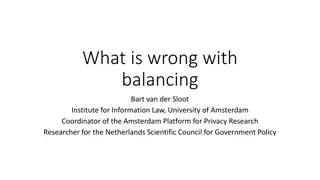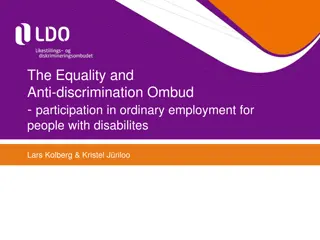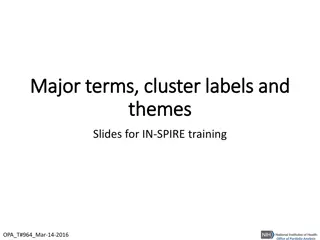Achieving Demographic Fairness in Clustering: Balancing Impact and Equality
This content discusses the importance of demographic fairness and balance in clustering algorithms, drawing inspiration from legal cases like Griggs vs. Duke Power Co. The focus is on mitigating disparate impact and ensuring proportional representation of protected groups in clustering processes. The results showcase approaches to achieve balance and fairness, including fairlet decomposition and strongly private clustering methods.
Download Presentation

Please find below an Image/Link to download the presentation.
The content on the website is provided AS IS for your information and personal use only. It may not be sold, licensed, or shared on other websites without obtaining consent from the author.If you encounter any issues during the download, it is possible that the publisher has removed the file from their server.
You are allowed to download the files provided on this website for personal or commercial use, subject to the condition that they are used lawfully. All files are the property of their respective owners.
The content on the website is provided AS IS for your information and personal use only. It may not be sold, licensed, or shared on other websites without obtaining consent from the author.
E N D
Presentation Transcript
Demographic Fairness: Balance
Inspiration Disparate Impact [FFMSV 15] Griggs vs Duke Power Co.: used non-racial features (notably, employee testing) as a proxy for race in order to discriminate against black employees in promotion Duke Power Co. lost in the Supreme court, and this was deemed unlawful This ruling and general philosophy helped promote affirmative action and anti-discrimination laws Why is this bad: It had a disproportionate and adverse impact on certain individuals. In other words, disparate impact. Applied to ML: Ensure that the impact of a system across protected groups is proportionate. Applied to Clustering: The impact on a group is measured by how many individuals of that group are in each cluster. Thus, we must ensure that the number of individuals from each group in each cluster is proportional to group size
Before: ??????? ? = 1/2 Demographic Fairness -Balance After: ??????? ? = 1 ??????? ?1 = 1 ??????? ?2 = 1 Recall: we are given points ? in a metric space. We pick centers ? ? and create a map ?:? ?. We also represent the clustering as a partitioning of points S. Assume the points in ? are given colors red or blue, representing protected classes. ??????? ?2 = 1 ??????? ?3 = 1 For a cluster ? : ??????? ?4 = 1/2 #???(?) #????(?),#????(?) ??????? ?4 = 1 ??????? ? = min #???(?) ??????? ?3 = 1/2 For a clustering ?: ??????? ? = min ? ????????(?) We want balance to be high (close to 1).
Results for Balance [CKLV 18] Lemma: Let ??????? ? ?/?for minimum integral ?and ?. Then we can find a clustering ?with balance at least ?/?and maximum cluster size ? + ?. 7 red, 10 blue ??????? ? 3/5 Method: Using the previous lemma, create a fairlet decomposition ?, which is a fair clustering with small (but possibly too many) clusters. Run a vanilla clustering algorithm on the fairlets centers as points duplicated to equal the size of the fairlet, call this set ? . The clustering is ?. 5 2 8 2 ? ? Structural result: for k-median and k-center, let the objective value be : ?,? = (?,?) + (? ,S)
Further Results for Balance [CKLV 18] Balanced problem solved Balance achieved Approximation factor Subroutine used Soubroutine approximation 1-center 1 3 1-center 2 1/? k-center 4 k-center 2 k-median 1 k-median 2 + 3 + ? 1 + 3 + ? ? + 1 + 3 + ? 1/? k-median k-median 1 + 3 + ? Hardness: it is NP-hard to optimally find a 1/? -balanced k-median clustering.
Fairness and Privacy [RS 18] General fairness results Finds a 12-approximate fairlet decomposition on any number of colors Implies: 14-approximation for k-center 15-approximationfor k-supplier Strongly private clustering Strong privacy: lower bounds on number of points of a color per cluster Results 4-approximate strongly private k-center 5-approximate strongly private k-supplier Fair and private clustering Privacy: lower bounds on the size of clusters Results: 40-approximate private and fair k-center 41-approximate private and fair k-supplier
Fairness and Essential Fairness [BGKKRSS 19] General fairness results 5-approximate fair k-center 7-approximate fair k-supplier Essentially Fair Fair Essentially fair results Clusterings with only additive fairness violations: 4 red, 8 blue: r/b = 1/2 E.g., you can have one extra red point in a cluster Results: Network flow Relaxed LP solution to fair clustering 3-approximate essentially fair k-center 5-approximate essentially fair k-supplier Fractional assignment to vanilla centers Round the fractional assignment 3.488-approximate essentially fair facility location 4.675-approximate essentially fair k-median 62.856-approximate essentially fair k-means Vanilla clustering approximation
Fair Spectral Clustering [KSAM 19] Definition Stochastic Block Model There is a fair ground truth clustering Generate edges of weight +1 according to color and ground truth cluster Fair spectral clustering Spectral clustering: create a clustering that minimizes the value of RatioCut Note: many edges omitted ? ? ?\C?(?) |?| ???????? ? = ? ? weights exiting a cluster to the size of the cluster Proposes a new spectral clustering algorithm: , e.g., the sum of the ratios of the Same color, same cluster: prob a Same color, different cluster: prob b Same cluster, different color: prob c Different cluster, different color: prob d Bounds the error relative to the ground truth clustering Uses O(n3) time, O(n2) space a > b > c > d
Summary - Balance First introduced as a concept in 2018 [CKLV 18] They also developed the fairlet decomposition technique and came up with initial results Many of the best approximations are from [BGKKRSS 19], who studied many clustering problems. Variants explored: With privacy [RS 18] Spectral Clustering [KSAM 19] Essential fairness [BGKKRSS 19]
Demographic Fairness: Bounded Representation
Demographic Fairness Bounded Representation [BGKKRSS 19] Instead of requiring perfect balance, we are only constrained by given bounds. There are multiple versions studied: -bounded for constant : Every color must represent at mostan fraction of any cluster , -bounded, for vectors , : For any color ? 1, ,? , color ? must represent at most an i fraction of any cluster and at least a i fraction of any cluster blue green red A clustering is fair if every cluster satisfies the bounded representation constraint. Fair down to =3/8 Fair down to red=3/8, blue=3/8, green=1/4 Fair up to red=3/8, blue=3/8, green=1/4 3/8 3/8 1/4 green blue red
Mitigating Over-Representation [AEKM 19] Fairness constraint: general upper bound Solve an LP relaxation on weights 3OPT Important technique: create a threshold graph on bichromatic edges of weight Results General : 3-approximation with violation 2 =1/t: 3-approximation with violation 1 =1/2: 12-approximation with no violation Filter facilities: only select distant ones Merge caplets into a fair clustering Round to an integral solution Here we lose some approximation factor and fairness Caplet decomp. on threshold graph (exists)
Fair Correlation Clustering [AEKM 20] Fairness constraint: general upper bound (also generalizes further) Low cost fairlet decomposition Reduces to median costs fairlets with bounded size Definition correlation clustering Edges are all +1 or -1 Minimize: the (weighted) sum of the +1 edges between clusters and -1 edges within clusters Transform decomposition to weighted corr clust Edge sign/weight depends on majority cut edges Fair correlation clustering (on c colors) =1/2: 256-approximation =1/c: (16.48c2)-approximation =1/t: O(t )-approximation for -approximate median cost fairlet decomposition Solve weighted corr clust Expand for final clust
Fair Hierarchical Clustering [AEKKMMPVW 20] Fairness constraint: general upper bound (also generalizes further) revenue Find a fairlet decomposition Extend previous methods Hierarchical clustering objectives Cost: initial objective, APX-hard Revenue: dual to cost, const-approximable Value: cost variant, const-approximable Extend previous methods to find arbitrary decomp Results Cost: O(n5/6log5/4n)-approximation (highly combinatorial methods) Revenue: (1/3-o(1))-approximation if =1/t or 2 colors Value: (2/3- )(1-o(1))-approximation Run a blackbox vanilla hierarchical clustering Attempt swapping points until found local approx. densest cut
General Bounds, Overlapping Groups [BCFN 19] Fairness constraint: specific lower and upper bound vectors , , also vertices can be in multiple groups (bounded by ) Find centers from a vanilla clustering Fair assignment problem: given a set of centers, what is the best way to create a fair clustering by assigning points to the centers? Solve the fair assignment relaxed LP Results Given a -approximate vanilla k-clustering for the p-norm, gives a +2 approximation with additive fairness violation 4 +3 Round using min degree bounded matroid methods
Probabilistic Fair Clustering [EBTD 20] Fairness constraint: specific lower and upper bound vectors , pblue +pred +pgreen = 1 Probabilistic setting Colors are not given. Each point has a probability of being assigned some color We guarantee that the expected number of each color in each cluster is bounded above/below Addresses any p-norm pred pgreen pblue Results Given a vanilla -approximation, there is a +2- approximation with +1 violation (2 colors) Given a vanilla -approximation, there is a +2- approximation with +1 violation (FPT, large clusters) For every cluster C, guarantee: ?? ? ? ? ?? Frequency of color i in cluster C
Fixing a Bounded Cost [EBSD 21] Fairness constraint: specific lower and upper bound vectors , Normal linear program Fair clustering under bounded cost Fix an upper bound for the clustering cost Minimize the degree of unfairness for any color (i.e., the proportional violation of upper and lower bounds) Utilitarian: minimize the sum of s Egalitarian: minimize the maximum Leximin: minimize the maximum , then second largest , Minimize: ????(?) Subject to: ?|?| |? ? | ?|?| New linear program Minimize: or max or maxmax Subject to: ???? ? ????? ????? Results Fair clustering (or assignment) under bounded cost is NP-hard Given a vanilla approximation, there are approximations for the fair bounded cost problem and: ? ? ? ? ( ?+ )|?|
Summary: Bounded Representation Two versions: -capped clustering Solved with very little to no additive fairness violation [AEKM 19] , -bounded, with upper and lower bound vectors Solved with additive fairness violation [BCFN 19] Variants explored: -capped correlation clustering -capped hierarchical clustering , -bounded probabilistic clustering , -bounded clustering with bounded cost However, both are stated in terms of union closed constraints
Demographic Fairness: Bounds on Chosen Centers
Let kred = kblue = kgreen = 1 This clustering is not fair. However this alternate clustering is fair Demographic Fairness Bounds on Chosen Centers Data summarization: do a k- clustering. The resulting centers are then outputted as representatives of the data set. Fairness: for every color i, there must be at least ki centers of color i.
Data Summarization [KAM 19, JNN 20] First introduced the fairness with regards to bounds on chosen centers. Results [KAM 19] Fair data summarization for k-center has a 5- approximation on 2 colors (tight) that runs in time O(kn) Fair data summarization for k-center has a (3 2c-1 1) approximation on c colors that runs in time O(kc2n + kc4) Results [JNN 20] Fair data summarization for k-center has a 3- approximation on c colors (tight) that runs in time O(kn)
Diversity-Aware k-Means [TOG 21] NP-Hard? FPT(k)? Approx factor Approx method General case Yes No X X c colors Yes ? 8 LP ??= ? ? [?] O(kc-1) LP calls c colors Yes ? 8 ??< ? ? [?] ?1+ ?2= ? ?1+ ?2< ? 2 colors Yes ? 3+ Local search 2 colors Yes ? 3+ O(k) local search calls
Demographic Fairness: Proportionality
Demographic Fairness Proportionality Idea: Every set of at least n/k points is entitled to its own cluster. Blocking coalition: a set of n/k points such that we can add a center that is closer to all points in the set than their assigned center. -proportional Benefits Pareto optimality: Let X andX be two proportional solutions. Then there is some point that X treats at least as well as X . Oblivious: Independent of sensitive attributes. Robust: Outliers cannot form coalitions. Scale invariant
Proportionally Fair Clustering [CFLM 19] Introduced the problem of proportionally fair clusterings. Hardness There may be no 2-proportional solution Results (1 + 2)-proportional solution ?(1)-proportional solution 8-approximates k-median Uniform random sampling approximately preserves the proportionality of any set of centers w.h.p. Good heuristic local search algorithm that finds nearly proportional solutions
More Proportionally Fair Clustering [MS 20] Considers [CFLM 19] in metric spaces defined by different norms. CFLM 19 Results 1 + 2 general approximation is really a 2-approximation for L2 Shows tightness of 1 + 2 approximation for L1 and L In L2, we cannot do better than 2/ 3 In L1 and L , we cannot do better than 1.4 Using tree distance or graph distance when ? ?/2, exact proportionality exists In L2 and many dimensions, checking existence is NP-hard, and the original algorithm is only in NP (it is a PTAS in the dimensionality) When there are infinitely many centers, proportionality preservation under random sampling holds even in L2 and many dimensions
Demographically Fair Clustering with Outliers
k-Clustering with Outliers Points ? in metric space with distance ?:?2 0 Pick ? ? with ? ? Pick ? ? with ? ? Construct ?:? ? such that some objective is minimized Allowed to exclude a certain number of points from the optimization objective: Robustness: Avoid noise in the data Scarce resources: Servicing only a certain fraction of the population is acceptable
Motivational Examples Clustering Setting: The points are users of a website. The website wants to cluster its users in groups of high similarity, so that it offers relevant recommendations. The cluster center is thought of as the most representative point of the cluster. Points with unique profiles might be excluded. Facility Location Setting: Points correspond to cities/towns/counties. A state wants to place vaccination sites in a metric space. Each point should have a vaccination center in close vicinity. Due to scarce resources, it may be acceptable to provide a good covering guarantee to only a fraction of the population.
Bias in Clustering with Outliers Being an outlier is disadvantageous!!! Example 1: Outliers will not receive any recommendations Example 2: Outliers will not enjoy close access to a vaccination center Suppose the points of ? come from ? demographic groups ?1, ,??. A solution can be biased if it disproportionately views points from certain groups as outliers.
Fair Clustering with Outliers Proposed fix: For each group ?? we are given a value ?? 0 Instead of ? ?, we now require ? ?? ?? for every ? ? Example with ????= 5 and ??????= 2 Arbitrary ?? values can capture a plethora of fairness scenarios Equitable treatment, e.g., ?? |??|/2 for all ? ? Preferential treatment, e.g., give a higher coverage guarantee to demographics that really need it
Results The problem has only been studied for the k-center objective, i.e., minimize max ? ??(?,?(?)), under the name Fair Colorful k-Center It was introduced by Bandyapadhyay et al. ( A Constant Approximation for Colorful k-Center - ESA 2019), who gave a 17-approximation algorithm for it in the Euclidean plane, when ? = ? 1 . Anegg et al. ( A Technique for Obtaining True Approximations for k-Center with Covering Constraints ) and Jia et al. ( Fair Colorful k-Center Clustering ) independently gave a 4-approximation and a 3-approximation respectively, both appearing in IPCO 2020. Both of the above algorithms work for general metrics, when ? = ?(1). Anegg et al. also showed that when ? is not a constant, there cannot exist any non-trivial approximation for the problem, unless P=NP.
Motivation In many clustering or facility location applications the quantity is ? ?,? ? (referred to as assignment distance ) is what really matters. Clustering: It measures how representative ? ? is for ?. Facility Location: It represents the distance ? needs to travel in order to reach its service provider ? ? . The smaller ? ?,? ? is the more satisfied the point ?. 1) Recall the previously mentioned recommendation system application. 2) Recall the previously mentioned vaccination sites allocation application. Conclusion: If ? consists of ? demographic groups ?1, ,??, then we should be fair in terms of the assignment distances provided to the points of different groups.
Results The problem was introduced independently by Ghadiri et al ( Socially Fair ?-Means Clustering ) and Abbasi et al. ( Fair Clustering via Equitable Group Representations ) at FAccT 2021. Both papers demonstrated an ?(?)-approximation algorithm. Makarychev and Vakilian ( Approximation Algorithms for Socially Fair Clustering COLT 2021) gave an ?( approximation ratio for the problem. ???? ???????)-approximation algorithm. They also showed that this is the best possible Goyal and Jaiswal ( Tight FPT Approximation for Socially Fair Clustering Arxiv 2021) give a ?. ? ? tight (3+ )-approximation algorithm for the problem, that runs in FPT time of
